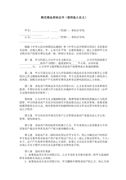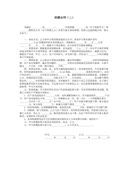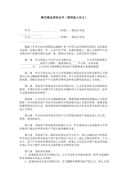5B Unit 4 教学设计(精选2篇)五年级英语教案
5B Unit 4 教学设计(精选2篇)
5B Unit 4 教学设计 篇1
第一部分 简要提示
一、年级:五年级 二、单元:unit 4
三、课题:an english friend 四、课型:新授课
五、教学内容:单元part a
六、教学目标:
1. 掌握单词well, e-mail, busy, usually, town, surf the internet
2.能听懂、会读、会说句型:
what does he/she do …? he/she …
does he/she …? yes, he/she does. no, he/she doesn’t.
七、教学重难点:
1. 单词usually和词组surf the internet的发音。
2. 初步了解掌握句型:
what does he/she do …? he/she …
does he/she …? yes, he/she does. no, he/she doesn’t.
第二部分 教学过程
第一步:重难点突破
t: hello, boys and girls. how are you this morning?
what day is it today ?
what lessons do you have in the morning?
what subject do you like ?
do you have any hobbies?
what’s his / her hobby?
do you play well ? does he play well ?(学生组词)
here well means 做某事做得好,for example, play football well, swim well.
t:now boys and girls, do you know my hobbies?
look at this picture , then guess .
t: i like surfing the internet. surf the internet, it means 网上冲浪.now let’s read this phrase together.
t: on the internet, we can do many interesting things.
t: yes. for example, we can listen to music, we can see films, we can play games, and we can write an email to our friends. here email means 电子邮件. now, please read this word after me.
t: look ! she is writing an email. do you usually write an email ? i usually write emails to my friends (.投影i usually) here usually means 经常. (投影) now, please read this word after me.
t: on sundays, i usually surf the internet. what do you usually do on sundays?
t: 同桌操练what do you usually do on sundays? i usually。。。
ask students (3组).
t: do you remember what does ⅹⅹ usually do on sundays?
s : he usually plays football.
第二步:课文学习
1. t: ⅹⅹusually plays football on sundays。 how about wang bing ?what does he usually do ? look ! this is wang bing. what is he doing now ? guess.
t: he is writing an e-mail to his english friend tom. gao shan comes in. ①what does gao shan want to do ?(listen to their dialogue听录音第二段)
t: he wants to play table tennis with wang bing.(板书gao shan wants to)
t: ②does wang bing go with gao shan? ③why?
no, he doesn’t. because he is busy. here busy means 繁忙的,忙碌的。now please read this word after me.
t: wang bing is very busy. he is writing an e-mail to his english friend, tom.
(板书wang bing is busy. he is…)
④看板书,师问生答 ⑤复述 can you say like this ?
t: . tom is wang bing’s english friend 。 where does tom live? does he live in london?(听录音两句话回答问题)
t: he lives in a small town near london. here town means 市镇,城镇。(组词)
(读句子并板书he lives。。。)
t: tom is wang bing’s english friend 。he lives in a small town near london . do you want to know something more about tom ? here ,i have some questions about tom.(师读问题)
t: what subjects does he study at school ?
does he study chinese ?
what does he usually do on sundays ?
does he play well? (听课文第三段录音,回答问题)
(生回答问题,师板书)
t: now, so much for the questions. now, please read the passage after the tape.(①跟录音朗读课文第二部分)。②read the text by yourselves自由读③use your own words to introduce tom.(看板书提示介绍tom)
第三步:巩固操练
①now, please open your english books ,read the text after the tape.
②retail the text.(根据板书复述课文)
第四步:homework:1.read the text three times.
2. introduce your friends.
5B Unit 4 教学设计 篇2
教学内容:
1.词汇:have lunch、 eleven 、 twelve
2.句型:what’s the time? it’s... o’clock. let’s… it’s time to…
教学目标:
1.熟练掌握1-12的数字和重点句型:what’s the time? it’s...o’clock. let’s… it’s time to…能熟练的运用新旧知识组织对话完成一定交际性语言任务。
2.激发学生学习英语的兴趣,调动学习积极性,引导学生积极与他人合作,在活动中培养学生的协作精神和竞争意识。
教学重难点:
创设优良的语言情景,让学生正确理解和掌握知识点,熟练运用单词句型进行对话。
课前准备:
1 cai课件
2教师课前自做的时间卡片(1:00~12:00)、图片钟(小狗形)、动物形状的卡片钟(正面时间、反面警示语)
教学步骤:
step1. free talk
t: are you happy today?s: yes.
t: let’s sing a song "bingo " . (展示cai课件)
学生边唱歌边做动作。
step2. warming up
t: what’s this? (教师指着课件上歌曲的最后一个画面,一只可爱的小狗问学生)
s: it’s a dog .
t: what’s his name?
s: bingo.
t: what’s this?(教师指着小狗头顶上的一朵黄花问学生)
s: it’s a flower.
step3. presentation
1. learn the new word: eleven
t: how many flowers can you see? let’s count. (教师指着花问学生,并点击鼠标依次出现11多黄花)
s: one、 two、 three…eleven.(教师帮助学生数到11)
呈现新词eleven,教师领读,学生跟读,抽查。
t: what colour is the flower? (教师指着黄花问学生)s: it’s yellow.
t: what colour is this flower ?(教师点击鼠标出现另一朵红色小花)s: it’s red .
2. learn the new word: twelve
t: how many flowers can you see now?
s: one 、 two、 three…twelve.(师生一起数12朵小花)
呈现新词twelve。开火车读,教师抽查。
教师出示自做单词卡片1-12 发给学生,让学生把单词帖在黑板上的小狗身上(此时在黑板上是小狗的反面),从而进行数字与单词的匹配训练。
3.learn the new sentence pattern: it’s …o’clock.
t:wow, can you guess what it is ?close your eyes .1.2.3 open your eyes.(教师问学生,然后展示小狗的正面,正面是小狗,小狗肚子是钟)
t: what’s this ?s: it’s a clock..
t: look, this is a clock . it’s six o’clock.
呈现新句型it’s six o’clock.,教师教读,学生跟读
教师转动钟面的指针和学生一起说时间(it’s one/two/three…o’clock)。教师出示时间卡片让学生练说时间。
4.learn the new sentence pattern: what’s the time ,please?
t: what’s the time ,please? (教师拿着最后的一张时间卡片问学生)
s: it’s seven o’clock..
呈现新句型what’s the time,please?教师教读,学生开火车读
t: what’s the time ,please? (教师呈现自做动物钟,正面是钟,钟上时间分别是7:00/8:00/12:00/5:00/3:00,反面是警示语,例如:请珍惜时间,时间可贵)
s: it’s seven o’clock.(如果学生回答对了,就作为奖品送给学生,并且提醒学生要珍惜时间)
师生操练完后,学生用自做的时间卡操练新句型,然后小组展示。
s1: what’s the time,please?s2: it’s two o’clock .
t: what’s the time ,please? (教师问最后一组同学)s1`2: it’s six o’clock.
cai呈现一个钟
t: what’s the time on the sceen? s: it’s six o’clock.
5.learn the new sentence pattern: let’s …now.
t: let’s get up now. (cai呈现小女孩起床的图片)
呈现新句型let’s get up now.跟读几遍,学生纵向朗读
t: let’s clap hands and say a rhyme.
以儿歌形式操练新句型,教师边击掌边念it’s six o’clock.. let’s get up now. 并且加上适当的肢体语言)
t: ok ,class. can you use your own style to say the rhyme. (cai上依次呈现两个男孩去上学let’s go to school. 两个男孩回家let’s go home .男孩睡觉let’s go to bed now.)
学生自由分配练说,然后进行小组比赛,看看哪组说的最好。
t: now, class. let’s say the rhyme together. (cai 上出现可爱的小熊,小熊身上是儿歌)
it’s six o’clock . let’s get up now.
it’s seven o’clock. let’s go to school now.
it’s five o’clock. let’s go home now.
it’s nine o’clock. let’s go to bed now.
6.learn the new sentence pattern:it’s time to…
t: oh, class. now i am hungry . what’s the time now? let’s look at the sceen.
s: it’s twelve o’clock.(cai上呈现一家人在吃午饭)
呈现新句型 it’s time to have lunch,教读,横排抽读。cai 上快速呈现get up /go to school / have lunch /go home/go to bed 等动作的情景,学生用新句型 it’s time to…练说。
t: now class ,please look at the sceen .it’s a tible .first please finish it ,and then make a dialogue with your partner.(让学生完成时间表,然后自编自演对话,巩固所学句型)
学生表演对话,并且进行比赛。
step4. consolidation
教师学生互动,以自身为钟,两臂为指针,肢体与口头并重,巩固所学句型。
step5. homework
把今天所学的内容应用于我们的日常生活,看谁用得多、用得好?
3b unit4教学设计 来自98e范文网。

















